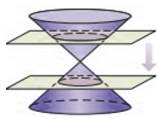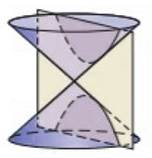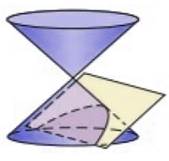
(a)
To explain : In the given case, when the intersection is not a
The point at which the upper cone ends and the lower cone starts will not be a circle.
Given information :
A plane perpendicular to the cone's axis passes through the cone, intersecting it in a circle whose radius decreases and then increases.

Explanation :
When a plane perpendicular to the cone's axis passes through the double napped cone and intersects the cone, it forms a
When the plane is moved from up to down then the point at which the upper cone ends and the lower cone starts, the radius will be zero, and therefore that point will not be a circle.
(b)
To explain : In the given case, when the intersection is not a hyperbola.
The point at which the two lines intersect is not a hyperbola.
Given information :
A plane parallel to the cone's axis passes through the cone, intersecting it in a hyperbola whose vertices get closer together and then farther apart.

Explanation :
When a plane parallel to the cone's axis passes through the double napped cone and intersects the cone, it forms a conic section called hyperbola.
When the plane passes through the axis of the double-napped cone, the point at which the two lines intersect is not a hyperbola.
Therefore the point at which the two lines intersect is not a hyperbola.
(c)
To explain : In the given case, when the intersection is not a parabola.
The point at which the plane gives a line is not a parabola.
Given information :
a plane parallel to the cone's nappe passes through the cone, intersecting it in a parabola that first gets narrower, then flips and gets wider.

Explanation :
When a plane parallel to the cone's nappe passes through the cone and intersects the cone, it forms a conic section called parabola.
When the plane moves from down to up of the double-napped cone, at the line of napping of the cones then the plane gives a line and this point is not a parabola.
Therefore the point at which the plane gives a line is not a parabola.
Chapter 8 Solutions
EBK ALGEBRA 2
- In simplest way, For each quadratic relation, find the zeros and the maximum or minimum. a) y = x 2 + 16 x + 39 b) y = 5 x2 - 50 x - 120arrow_forwardIn simplest terms and step by step Write each quadratic relation in standard form, then fi nd the zeros. y = - 4( x + 6)2 + 36arrow_forwardIn simplest terms and step by step For each quadratic relation, find the zeros and the maximum or minimum. 1) y = - 2 x2 - 28 x + 64 2) y = 6 x2 + 36 x - 42arrow_forward
- Write each relation in standard form a)y = 5(x + 10)2 + 7 b)y = 9(x - 8)2 - 4arrow_forwardIn simplest form and step by step Write the quadratic relation in standard form, then fi nd the zeros. y = 3(x - 1)2 - 147arrow_forwardStep by step instructions The path of a soccer ball can be modelled by the relation h = - 0.1 d 2 + 0.5 d + 0.6, where h is the ball’s height and d is the horizontal distance from the kicker. a) Find the zeros of the relation.arrow_forward
 Algebra and Trigonometry (6th Edition)AlgebraISBN:9780134463216Author:Robert F. BlitzerPublisher:PEARSON
Algebra and Trigonometry (6th Edition)AlgebraISBN:9780134463216Author:Robert F. BlitzerPublisher:PEARSON Contemporary Abstract AlgebraAlgebraISBN:9781305657960Author:Joseph GallianPublisher:Cengage Learning
Contemporary Abstract AlgebraAlgebraISBN:9781305657960Author:Joseph GallianPublisher:Cengage Learning Linear Algebra: A Modern IntroductionAlgebraISBN:9781285463247Author:David PoolePublisher:Cengage Learning
Linear Algebra: A Modern IntroductionAlgebraISBN:9781285463247Author:David PoolePublisher:Cengage Learning Algebra And Trigonometry (11th Edition)AlgebraISBN:9780135163078Author:Michael SullivanPublisher:PEARSON
Algebra And Trigonometry (11th Edition)AlgebraISBN:9780135163078Author:Michael SullivanPublisher:PEARSON Introduction to Linear Algebra, Fifth EditionAlgebraISBN:9780980232776Author:Gilbert StrangPublisher:Wellesley-Cambridge Press
Introduction to Linear Algebra, Fifth EditionAlgebraISBN:9780980232776Author:Gilbert StrangPublisher:Wellesley-Cambridge Press College Algebra (Collegiate Math)AlgebraISBN:9780077836344Author:Julie Miller, Donna GerkenPublisher:McGraw-Hill Education
College Algebra (Collegiate Math)AlgebraISBN:9780077836344Author:Julie Miller, Donna GerkenPublisher:McGraw-Hill Education





